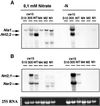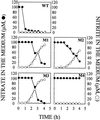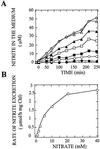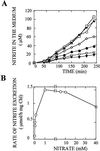Nitrite reductase mutants as an approach to understanding nitrate assimilation in Chlamydomonas reinhardtii
- PMID: 10631272
- PMCID: PMC58867
- DOI: 10.1104/pp.122.1.283
Nitrite reductase mutants as an approach to understanding nitrate assimilation in Chlamydomonas reinhardtii
Abstract
We constructed mutant strains lacking the nitrite reductase (NR) gene in Chlamydomonas reinhardtii. Two types of NR mutants were obtained, which either have or lack the high-affinity nitrate transporter (Nrt2;1, Nrt2;2, and Nar2) genes. None of these mutants overexpressed nitrate assimilation gene transcripts nor NR activity in nitrogen-free medium, in contrast to NR mutants. This finding confirms the previous role proposed for NR on its own regulation (autoregulation) and on the other genes for nitrate assimilation in C. reinhardtii. In addition, the NR mutants were used to study nitrate transporters from nitrite excretion. At high CO(2), only strains carrying the above high-affinity nitrate transporter genes excreted stoichiometric amounts of nitrite from 100 microM nitrate in the medium. A double mutant, deficient in both the high-affinity nitrate transporter genes and NR, excreted nitrite at high CO(2) only when nitrate was present at mM concentrations. This suggests that there exists a low-affinity nitrate transporter that might correspond to the nitrate/nitrite transport system III. Moreover, under low CO(2) conditions, the double mutant excreted nitrite from nitrate at micromolar concentrations by a transporter with the properties of the nitrate/nitrite transport system IV.
Figures






Similar articles
-
The activity of the high-affinity nitrate transport system I (NRT2;1, NAR2) is responsible for the efficient signalling of nitrate assimilation genes in Chlamydomonas reinhardtii.Planta. 2002 Aug;215(4):606-11. doi: 10.1007/s00425-002-0778-5. Epub 2002 Apr 17. Planta. 2002. PMID: 12172843
-
Three Nrt2 genes are differentially regulated in Chlamydomonas reinhardtii.Mol Gen Genet. 1998 May;258(4):373-7. doi: 10.1007/s004380050743. Mol Gen Genet. 1998. PMID: 9648741
-
Nitrate and nitrate are transported by different specific transport systems and by a bispecific transporter in Chlamydomonas reinhardtii.J Biol Chem. 1996 Jan 26;271(4):2088-92. doi: 10.1074/jbc.271.4.2088. J Biol Chem. 1996. PMID: 8567664
-
Nitrate and nitrite transport in bacteria.Cell Mol Life Sci. 2001 Feb;58(2):215-24. doi: 10.1007/PL00000849. Cell Mol Life Sci. 2001. PMID: 11289303 Free PMC article. Review.
-
Eukaryotic nitrate and nitrite transporters.Cell Mol Life Sci. 2001 Feb;58(2):225-33. doi: 10.1007/PL00000850. Cell Mol Life Sci. 2001. PMID: 11289304 Free PMC article. Review.
Cited by
-
The Chlamydomonas reinhardtii Nar1 gene encodes a chloroplast membrane protein involved in nitrite transport.Plant Cell. 2000 Aug;12(8):1441-53. doi: 10.1105/tpc.12.8.1441. Plant Cell. 2000. PMID: 10948261 Free PMC article.
-
On-line estimation of O(2) production, CO(2) uptake, and growth kinetics of microalgal cultures in a gas-tight photobioreactor.J Appl Phycol. 2007 Apr;19(2):161-174. doi: 10.1007/s10811-006-9122-y. Epub 2006 Nov 29. J Appl Phycol. 2007. PMID: 19396354 Free PMC article.
-
Phylogenomic and Microsynteny Analysis Provides Evidence of Genome Arrangements of High-Affinity Nitrate Transporter Gene Families of Plants.Int J Mol Sci. 2021 Dec 3;22(23):13036. doi: 10.3390/ijms222313036. Int J Mol Sci. 2021. PMID: 34884876 Free PMC article.
-
REM1, a new type of long terminal repeat retrotransposon in Chlamydomonas reinhardtii.Mol Cell Biol. 2005 Dec;25(23):10628-38. doi: 10.1128/MCB.25.23.10628-10638.2005. Mol Cell Biol. 2005. PMID: 16287873 Free PMC article.
-
Nitrous Oxide Emissions from Nitrite Are Highly Dependent on Nitrate Reductase in the Microalga Chlamydomonas reinhardtii.Int J Mol Sci. 2022 Aug 20;23(16):9412. doi: 10.3390/ijms23169412. Int J Mol Sci. 2022. PMID: 36012676 Free PMC article.
References
Publication types
MeSH terms
Substances
LinkOut - more resources
Full Text Sources

